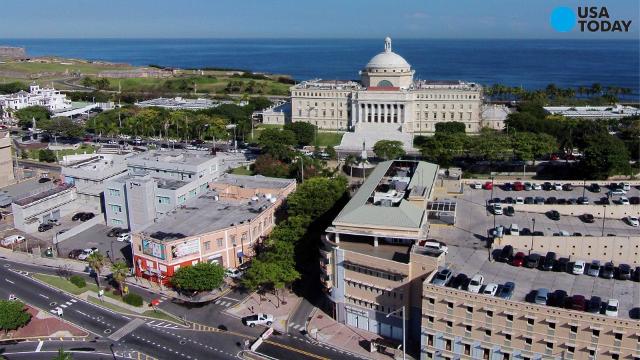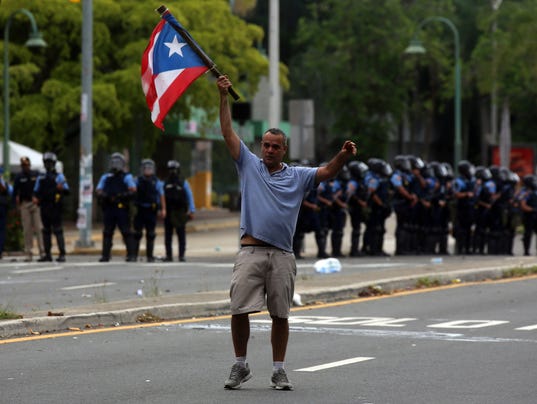
Embed
Share
Puerto Rico's financial oversight board has filed a form of bankruptcy for the island under Title III of last year's Puerto Rico rescue law, which is known as PROMESA. USA TODAY

People face off with police during the general strike against austerity measures, which coincides with the International Workers Day, in San Juan, Puerto Rico, on May 1. (Photo: THAIS LLORCA, EPA)
Facing mountainous debt and population loss, the board overseeing Puerto Rico filed Wednesday for the equivalent of bankruptcy protection in a historic move that's sure to trigger a fierce legal battle with the fate of the island's citizens, creditors and workers at stake.
The oversight board appointed to lead the U.S. territory back to fiscal sustainability declared in a court filing that it is "unable to provide its citizens effective services," crushed by $74 billion in debts and $49 billion in pension liabilities.
The filing casts a shadow of uncertainty over the future of Puerto Rico pensioners, American retirees who own the island's debt, institutional investors who backed the island in good times and businesses with lucrative contracts.
But it could also provide hope to residents seeking to preserve access to basic services such as public safety and health care, while also offering a potential route to economic stability for an island that has been suffering for years. Puerto Rico officials have complained that their debt crisis has cut off funds needed to pay doctors and run schools.
Puerto Rico has lost 20% of its jobs since 2007 and 10% of its population, sparking an economic crisis that worsens by the day.
The island's response has worsened matters. Politicians raised taxes, allowed governmental bureaucracy to balloon, borrowed to pay the bills and promised pensions that the island could not afford.
"The result is that Puerto Rico can no longer fully pay its debt and pay for government services," the oversight board said in the court filing. "Nor can Puerto Rico refinance its debt — it no longer has access to the capital markets. In short, Puerto Rico’s crisis has reached a breaking point."
The island's slumping economy was, perhaps, the final straw. Some six in 10 Puerto Ricans are unemployed or not interested in working, and nearly half are enrolled in Medicaid.
Puerto Ricans are U.S. citizens and can move to the mainland at any time, draining the island's tax base. Tens of thousands have streamed into Florida.
The legal case is not technically considered a bankruptcy filing under the federal code that governs municipal cases, but it's similar. Instead, it was filed through a bankruptcy-like mechanism dubbed Title III of legislation authorized by Congress and signed into law by President Obama in 2016.
Here are key questions:
What happens next?
U.S. Supreme Court Chief Justice John Roberts will appoint a life-tenured judge, likely a U.S. District Court judge, to oversee the case, said Melissa Jacoby, a University of North Carolina law professor and expert on municipal bankruptcy.
That's different than Chapter 9 municipal bankruptcy cases, where a bankruptcy judge controls the process.
The person appointed to oversee the case will have significant power over how it unfolds.
This particular debt-cutting process has never occurred, so the lack of legal precedent could leave the judge with much sway over the future of Puerto Rico.
What does the oversight board do?
The oversight board will aim to negotiate debt cuts with creditors, after which it will propose a plan of adjustment. The judge will decide whether to authorize the plan, which could lead to massive debt cuts.
How will investors be treated?
They're in trouble.
To be sure, it depends on the status of their debt. If they hold secured bonds, they might get paid in full. But unsecured bondholders could suffer significant cuts, depending on which types of debt the judge determines to be vulnerable.
Financial creditors, including major investors that had bet on Puerto Rico bonds that were exempt from federal, state and local taxes, argue that their investments were made when the island was not eligible for bankruptcy.
But Congress passed the Puerto Rico Oversight, Management and Economic Stability Act (PROMESA) specifically to create a process that allows the island's numerous debt-saddled governmental entities to achieve debt relief.
Complicating matters is the various governmental entities included in the bankruptcy filing, each of which has its own investors and creditors wanting to be paid.
"It really isn’t clear how creditors stack up against each other," Jacoby said.
Moody's Investor Service Vice President Ted Hampton concluded Wednesday that the bankruptcy filing is actually "a positive step for bondholders overall" because it will bring about "orderly process that should be better for creditors in the aggregate than a chaotic and uncertain period involving proliferating lawsuits."
What happens to Puerto Rico pensioners?
They might face cuts because Puerto Rico has run out of pension funds.
In the Chapter 9 bankruptcy of Detroit, retirees agreed to accept cuts after a federal judge ruled that their pensions could be cut in municipal bankruptcy. That could pave the way for a similar ruling in Puerto Rico.
The PROMESA law states that the oversight board must identify a fiscal plan that will "provide adequate funding for public pension systems."
Puerto Rico pensioners also have certain legal protections, but inside of bankruptcy those protections can collapse. That's exactly what happened in Detroit.
That's why pension cuts and reductions to health care insurance could be in the cards.
But pensioners may still fare better than investors, Municipal Market Analytics analyst Matt Fabian suggested Tuesday in a research note. That's because pensioners are more politically empathetic than Wall Street creditors and bond insurers.
Could Puerto Rico sell off assets to pay some debts?
That's possible. In Detroit, which had $18 billion in debt, the city faced pressure from creditors and pensioners to consider selling off the city-owned Detroit Institute of Arts. The city instead negotiated a deal to avoid liquidating art and collected an infusion of cash from private donors and the state of Michigan.
The city could not be forced to sell assets because Chapter 9 bankruptcy prevents federal judges from ordering municipalities to take such actions.
Similarly, PROMESA dictates that the court may not "interfere with" the island's "property or revenues," without the oversight board's consent.
So a judge may not be able to order the island to sell off beachfront property.
But that doesn't mean creditors won't try to pressure the island into it.
"I wouldn’t be surprised because we’ve seen it in other contexts," Jacoby said.
Follow USA TODAY reporter Nathan Bomey on Twitter @NathanBomey.
Không có nhận xét nào:
Đăng nhận xét